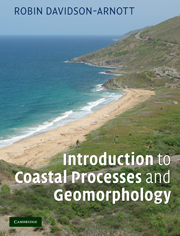5 - Waves – wave theory and wave dynamics
from Part II - Coastal Processes
Summary
Synopsis
Wave theories provide a mathematical description of changes in the form of waves, and the orbital motion associated with them, from deep water to the breaker line and into the surf zone. Because of the limitations imposed by assumptions about the wave form and water depth, no one theory is valid over the full range of conditions. The theories can be used simply to predict wave height, celerity and length in any water depth as well as functions associated with the orbital motion, such as the maximum orbital motion near the bed and the orbital diameter. The formulae for the simplest theories can be programmed in a spread sheet, and there are computer programs available that will provide solutions for all of the basic theories. These theories also provide the basis for complex numerical simulation models that are used to predict waves, currents and sediment transport in the nearshore and breaker zones.
Wave shoaling describes changes to the wave form and orbital motion as it moves into shallow water. During the process of shoaling, interaction with the underwater topography results in a bending of the direction of travel of the wave crests so that they conform to the shape of the depth contours, a process termed wave refraction. Wave refraction leads to a concentration of wave energy in some location, especially headlands, and a divergence of energy in other areas.
Information
- Type
- Chapter
- Information
- Introduction to Coastal Processes and Geomorphology , pp. 78 - 115Publisher: Cambridge University PressPrint publication year: 2009
